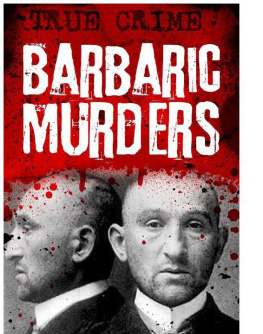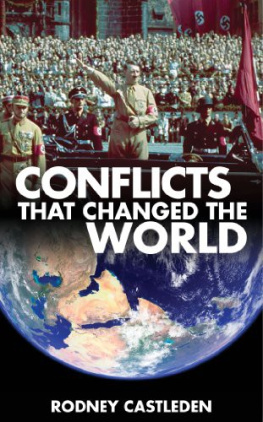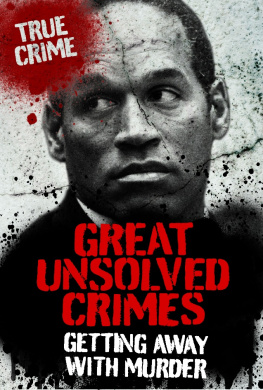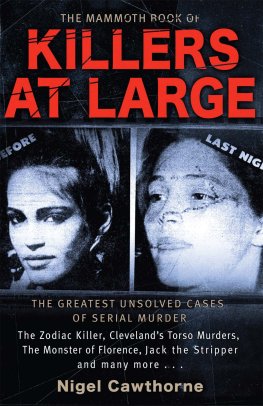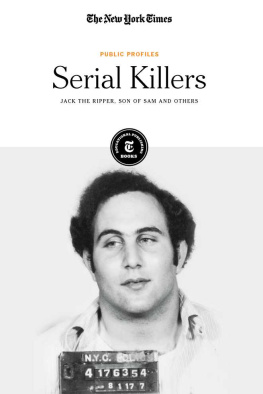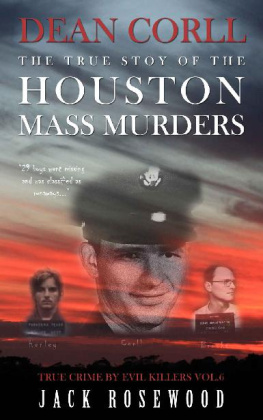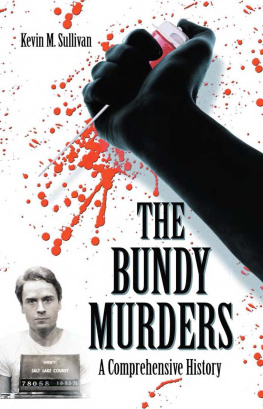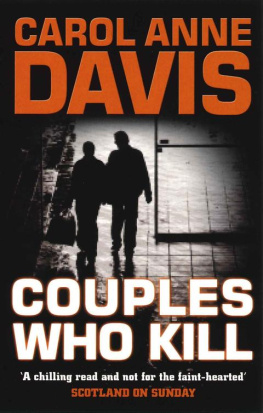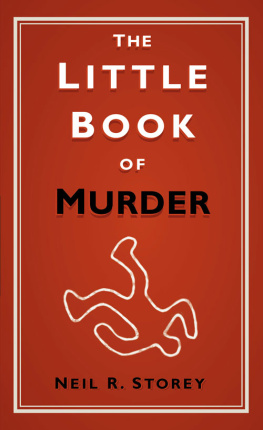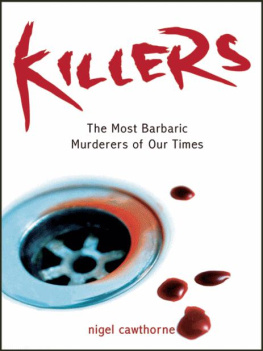Castleden - Barbaric Murders - Child victims, lady-killers and bodies in boxes (Infamous Murderers)
Here you can read online Castleden - Barbaric Murders - Child victims, lady-killers and bodies in boxes (Infamous Murderers) full text of the book (entire story) in english for free. Download pdf and epub, get meaning, cover and reviews about this ebook. year: 2011, publisher: Canary Press, genre: Detective and thriller. Description of the work, (preface) as well as reviews are available. Best literature library LitArk.com created for fans of good reading and offers a wide selection of genres:
Romance novel
Science fiction
Adventure
Detective
Science
History
Home and family
Prose
Art
Politics
Computer
Non-fiction
Religion
Business
Children
Humor
Choose a favorite category and find really read worthwhile books. Enjoy immersion in the world of imagination, feel the emotions of the characters or learn something new for yourself, make an fascinating discovery.
- Book:Barbaric Murders - Child victims, lady-killers and bodies in boxes (Infamous Murderers)
- Author:
- Publisher:Canary Press
- Genre:
- Year:2011
- Rating:4 / 5
- Favourites:Add to favourites
- Your mark:
- 80
- 1
- 2
- 3
- 4
- 5
Barbaric Murders - Child victims, lady-killers and bodies in boxes (Infamous Murderers): summary, description and annotation
We offer to read an annotation, description, summary or preface (depends on what the author of the book "Barbaric Murders - Child victims, lady-killers and bodies in boxes (Infamous Murderers)" wrote himself). If you haven't found the necessary information about the book — write in the comments, we will try to find it.
Barbaric Murders - Child victims, lady-killers and bodies in boxes (Infamous Murderers) — read online for free the complete book (whole text) full work
Below is the text of the book, divided by pages. System saving the place of the last page read, allows you to conveniently read the book "Barbaric Murders - Child victims, lady-killers and bodies in boxes (Infamous Murderers)" online for free, without having to search again every time where you left off. Put a bookmark, and you can go to the page where you finished reading at any time.
Font size:
Interval:
Bookmark:

Barbaric Murders
Child victims, lady-killers and bodies in boxes
R ODNEY C ASTLEDEN

To check out more titles by Canary Press visit www.canarypress.co.uk
Brought to you by KeVkRaY
CONTENTS
PART ONE: CHILD VICTIMS
St William of Norwich
and the blood lie
St William of Norwich was born in 1132. He is thought to have died on 22 March, 1144, though his body was not found until three days later, on Holy Saturday, the day between Good Friday and Easter Day. The timing of the boys death in relation to the Church calendar held strong symbolic significance to the Norwich clerics, which helps to explain how both the boy and his death acquired mythic status in the Middle Ages.
The starting-point of the story is simple enough. A boys body was found in Thorpe Wood near Norwich; it bore signs of a violent death. No-one touched it until the feast of Easter was over. On Easter Monday the corpse was buried where it was found. In the meantime a number of boys and young men had visited the spot, which means that the body could easily have been mischievously tampered with, and significant wounds added in imitation of the wounds of Christ. Jews were suspected of murdering the boy on account of the nature of the wounds.
The body was identified as that of a boy called William, a tanners apprentice. It was later said that he had frequently visited the houses of certain Jews with his master, a fact which seemed to implicate the Jews.
Williams uncle, who was the priest Godwin Stuart, opened the grave to be sure of the identification. The burial service was read and the corpse re-buried. A few days later the diocesan synod met under Bishop Eborard and Godwin Stuart took the opportunity to accuse the Jews of committing the murder of his nephew. He offered to prove his accusation by ordeal. The Jews of Norwich were the kings men and directly under the sheriffs protection; the sheriff had to point out that the Bishop had no jurisdiction over the Jews. No formal condemnation of the Jews was possible because of the strength of character and purpose of the Sheriff of Norwich, who conscientiously and strong-mindedly protected the Jewish community from Church interference.
The only thing Godwin Stuart was able to achieve was the translation of his nephews body from Thorpe Wood to the monks cemetery. This was done on 24 April.
An attempt was made to develop a cult of St William, but it never really caught on. A couple of miracles were reported in the five years following his death. Probably the story of poor St Williams (alleged) murder by the Jews would have faded and been forgotten, but for another murder in 1149.
The Jew Eleazar was murdered by the retainers of Sir Simon de Novers. The Jewish community demanded that the murderer should be punished. Bishop Turbe, who had succeeded to the see of Norwich in 1146, acted for the accused, who was his own tenant, and took the opportunity to bring up the murder of William five years before as a counter-charge. The case was tried before the King at Norwich, but had to be put off, according to the chronicler, because the Norwich Jews paid a large sum of money to the King and his councillors.
Bishop Turbe was keen to revive the blood lie, the dangerous myth that Jews performed human sacrifices, and this was his reason for bringing up the case of William. He was partly responsible for perpetuating the cult, as was Richard de Ferraiis, who became Prior in 1150, after the bones of St William were translated to the chapter-house. Thomas of Monmouth, the chronicler, became the saints personal sacrist. Thomas had three visions in which he saw Herbert of Losinga, the cathedrals founder, ordering the boys body to be exhumed and reburied in the chapter-house. This was done in 1151. The body was moved again, in 1154, to the apsidal chapel of the Holy Martyrs, now known as the Jesus Chapel.
Once the body was inside the cathedral, the miracles started to multiply, and St Williams cult really took off. Thomas of Monmouth wrote down the story of what had happened to St William. This was now some long time after the boys death, and Thomas seems to have believed whatever anybody told him. The result is a highly coloured and prejudiced version of events, and probably does not represent what really happened at all. But this, in summary, is what he said.
William had been in the habit of visiting the houses of Jews and was forbidden by his friends to have anything to do with them. On the Monday of Holy Week in 1144, he was lured away from his mother by a messenger who offered him a job in the archdeacons kitchen. The next day William was seen with the messenger going into a Jews house. William was never again seen alive. On the Wednesday of that week, following a service in the synagogue, the Jews lacerated his forehead with thorns, and then crucified him. A Christian servant carrying some hot water ordered by her master saw, through a crack in the door, a boy tied to a post; she assumed the water was to cleanse the boys body. Later she found a boys belt in the room. Many years later she pointed out to Thomas the evidence of the martyrdom in the same room. A month after the boys martyrdom, thorn-points were found on Williams head and the wounds of the martyrdom in his hands, feet and side.(Significantly, this servants testimony was not produced until Thomas was preparing his book.)
On the Thursday, the Jews discussed how to dispose of the boys body.(If the Jews really had premeditated the killing as a human sacrifice, they would have planned this beforehand. If there is any truth at all in Thomass story, the boys death must have been an accident, possibly some rough horseplay as at Inmestar. In ad 415 at Inmestar in Syria, some Jews in a drunken frolic accidentally killed a Christian child in a mock Crucifixion.)
On the Friday, Good Friday, Eleazar and another Jew carried the boys body in a sack to Thorpe Wood.(Eleazar was a cunning choice; he had just been murdered himself, and therefore in no position to defend himself. The charge also somehow vindicated his killing by a Christian.)
On the way to dispose of the body, they were met by a man called Aelward Ded, who saw what was inside the sack. The Jews bribed the sheriff (always Thomass enemy, because he was the Jews protector) to extort an oath of silence from Aelward. It was only five years later, after the sheriffs death and when on his own death-bed, that Aelward told his story. (Here Thomas was explaining away the late emergence of corroboration for his story. The Jews may well have stumped up large amounts of money. They were besieged, frightened people, and would naturally have resorted to paying protection money if it meant they would be left alone for a while; even if these payments were made, they do not in any way prove their guilt.)The most destructive piece of evidence that Thomas produced was the testimony of Theobald, who was a converted Jew and a monk at Norwich Priory. Theobald told Thomas that in the ancient writings of the Jews it was said that they could only obtain their freedom and return to their fatherland if a certain ceremony was performed. This was the annual sacrifice, somewhere in the world, of a Christian; in the year 1144 it had been the turn of the Norwich Jews to perform this human sacrifice.
This was the infamous blood lie, which has been described as one of the most notable and disastrous lies of history. It has been widely used, right through the last thousand years, as the justification for persecuting Jews everywhere and provides the backdrop to horrors such as the Holocaust. The idea of the blood lie may seem preposterous, but there were scholars in the late nineteenth century who were ready to support it by writing learned dissertations proving that throughout history the Jews have indulged in the sacrifice of children.
Next pageFont size:
Interval:
Bookmark:
Similar books «Barbaric Murders - Child victims, lady-killers and bodies in boxes (Infamous Murderers)»
Look at similar books to Barbaric Murders - Child victims, lady-killers and bodies in boxes (Infamous Murderers). We have selected literature similar in name and meaning in the hope of providing readers with more options to find new, interesting, not yet read works.
Discussion, reviews of the book Barbaric Murders - Child victims, lady-killers and bodies in boxes (Infamous Murderers) and just readers' own opinions. Leave your comments, write what you think about the work, its meaning or the main characters. Specify what exactly you liked and what you didn't like, and why you think so.

